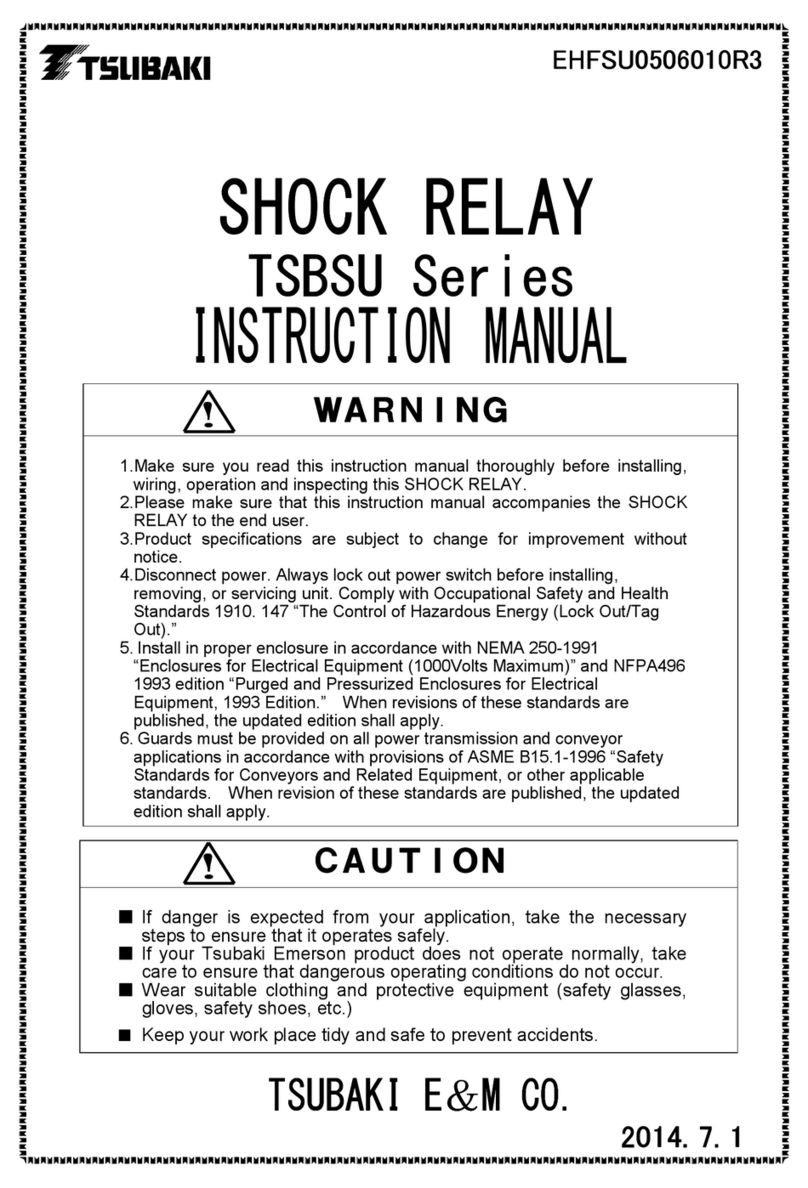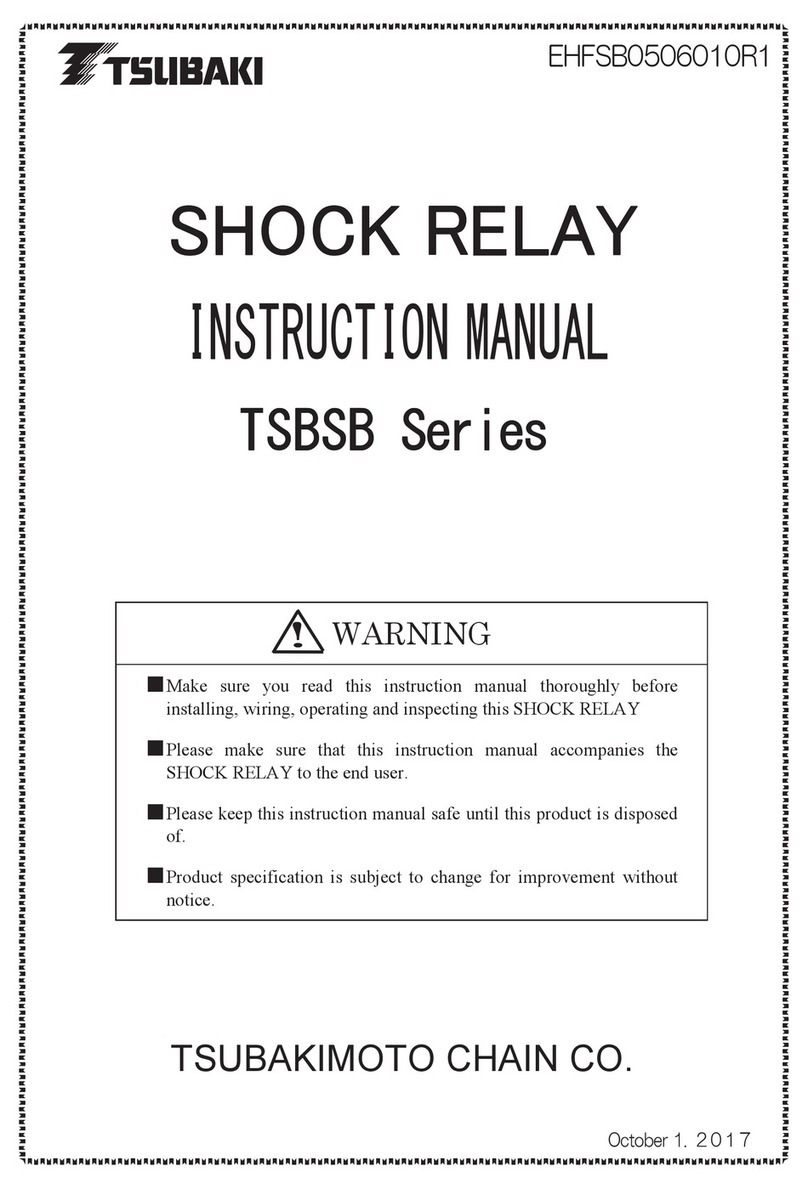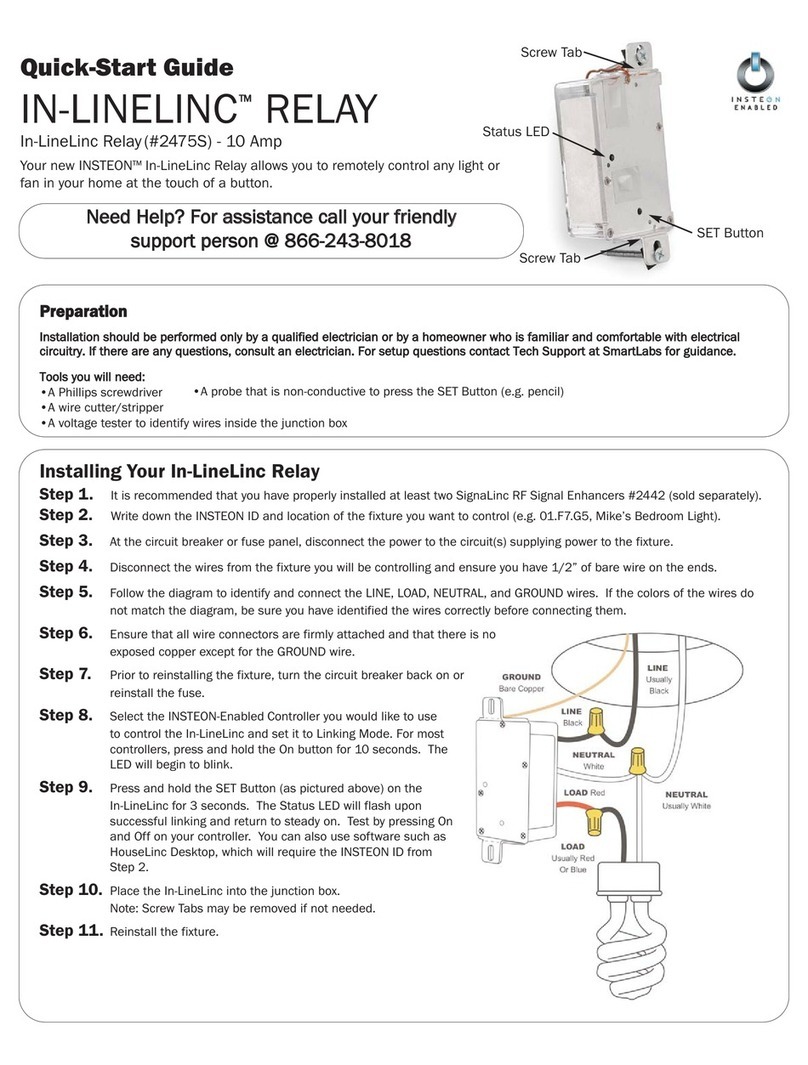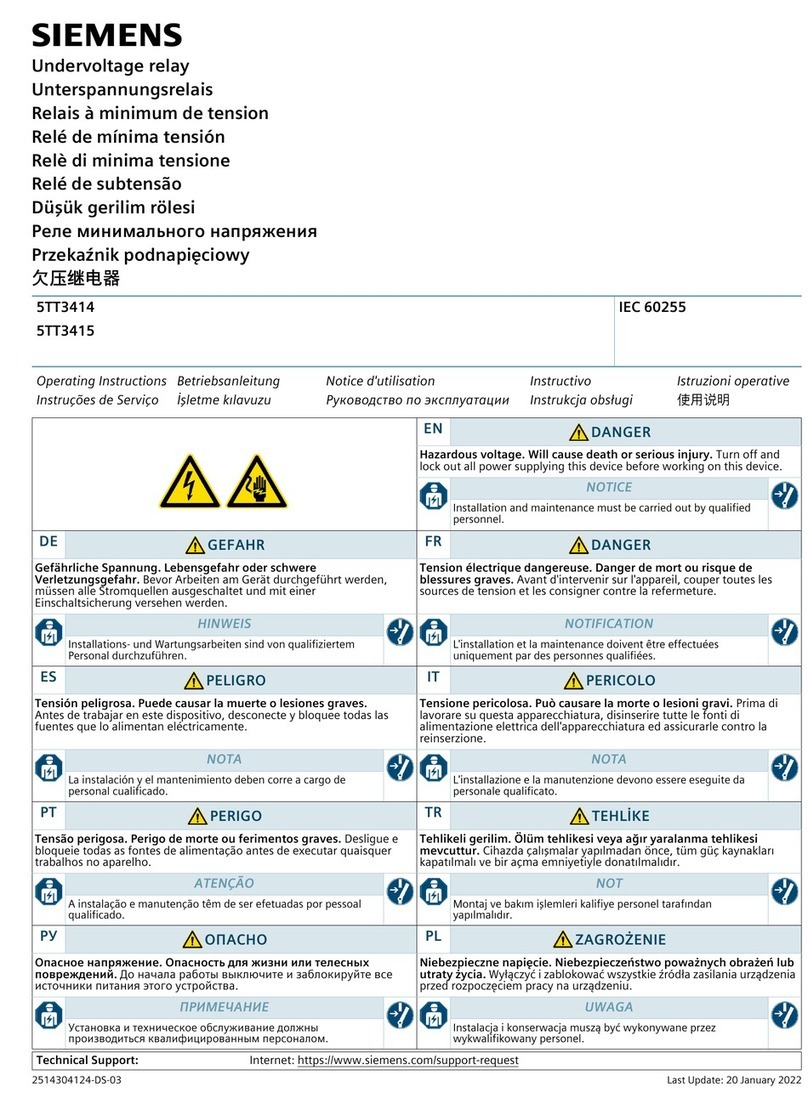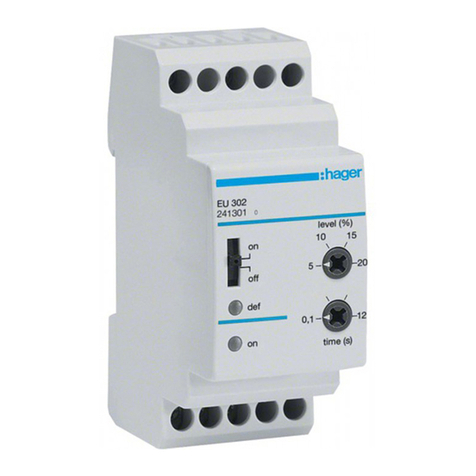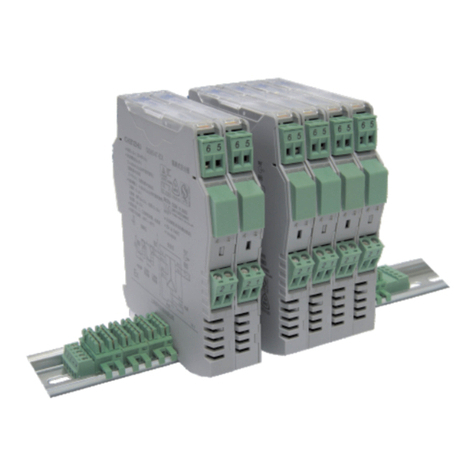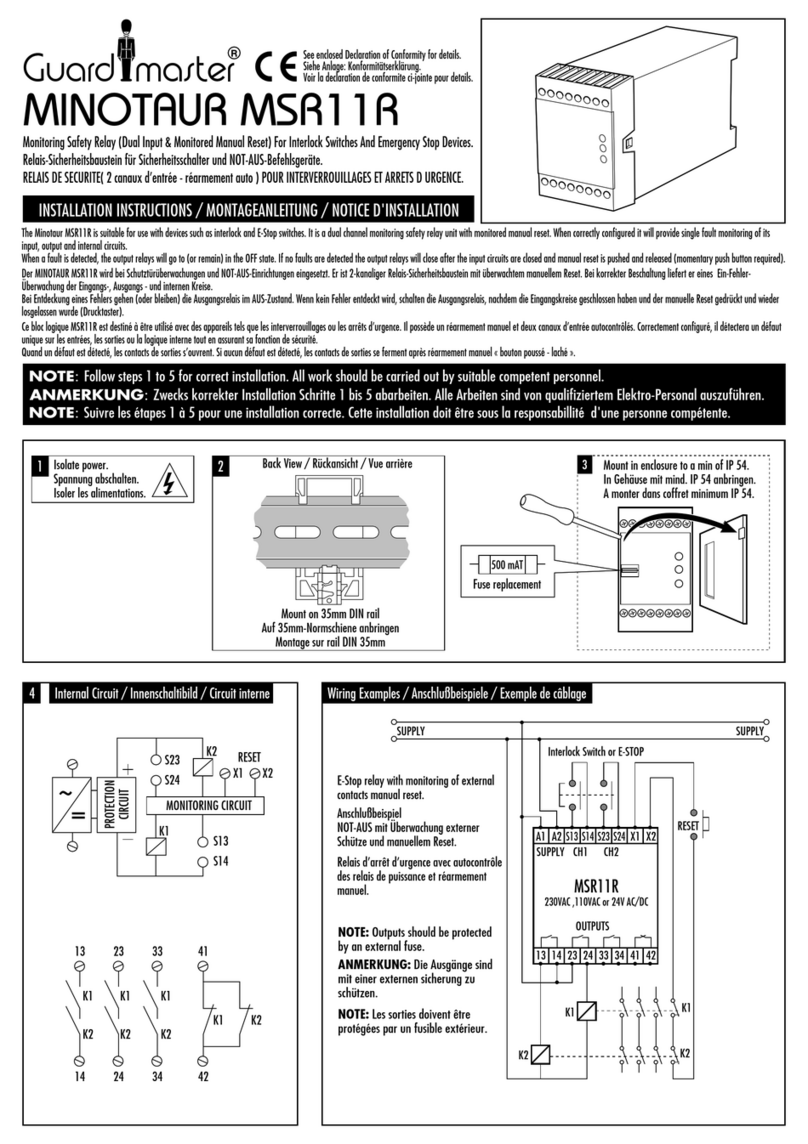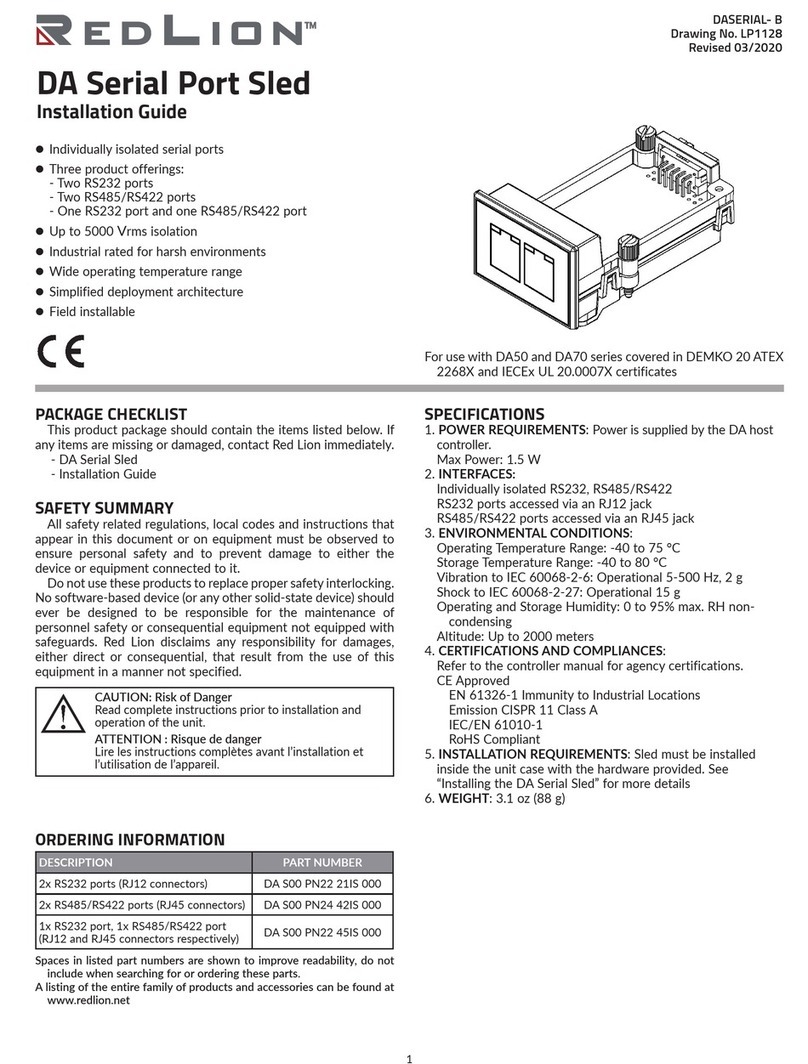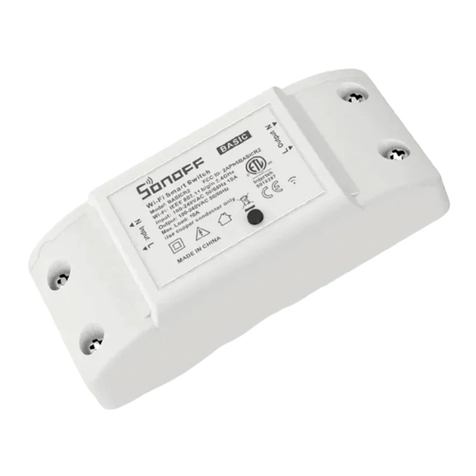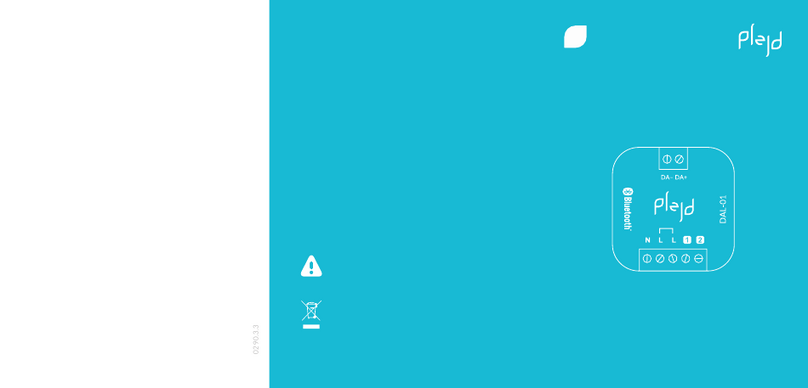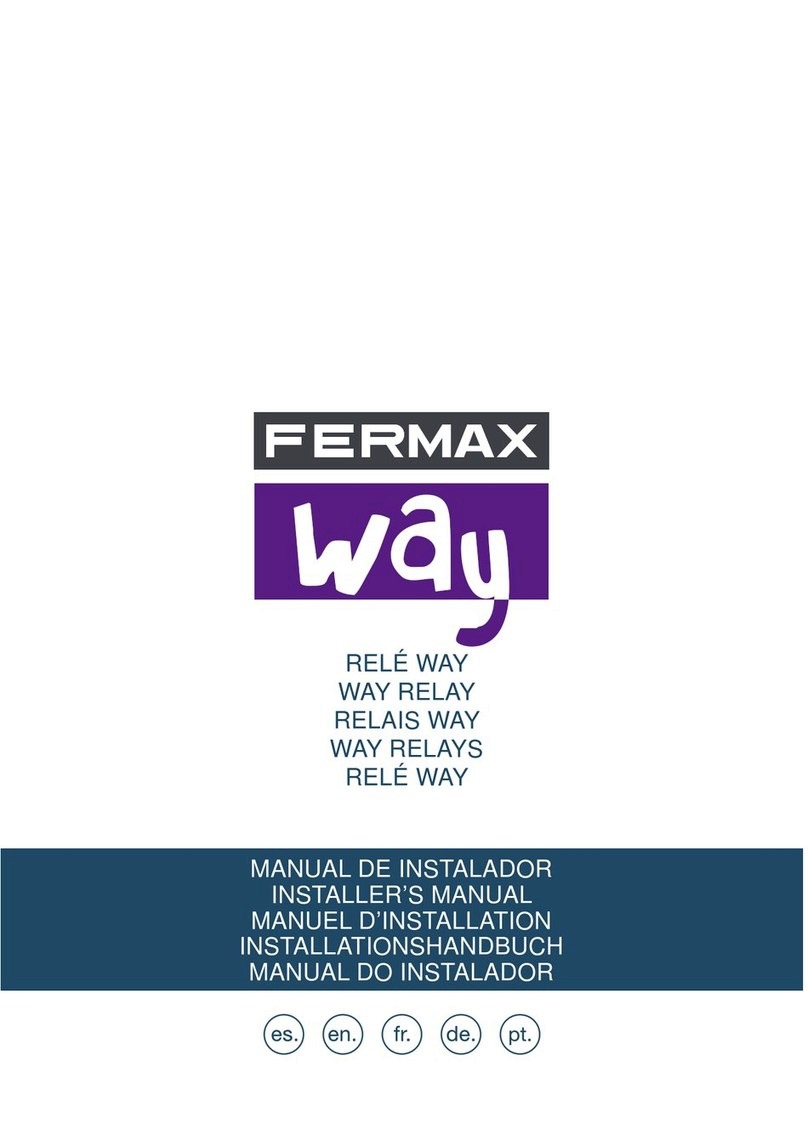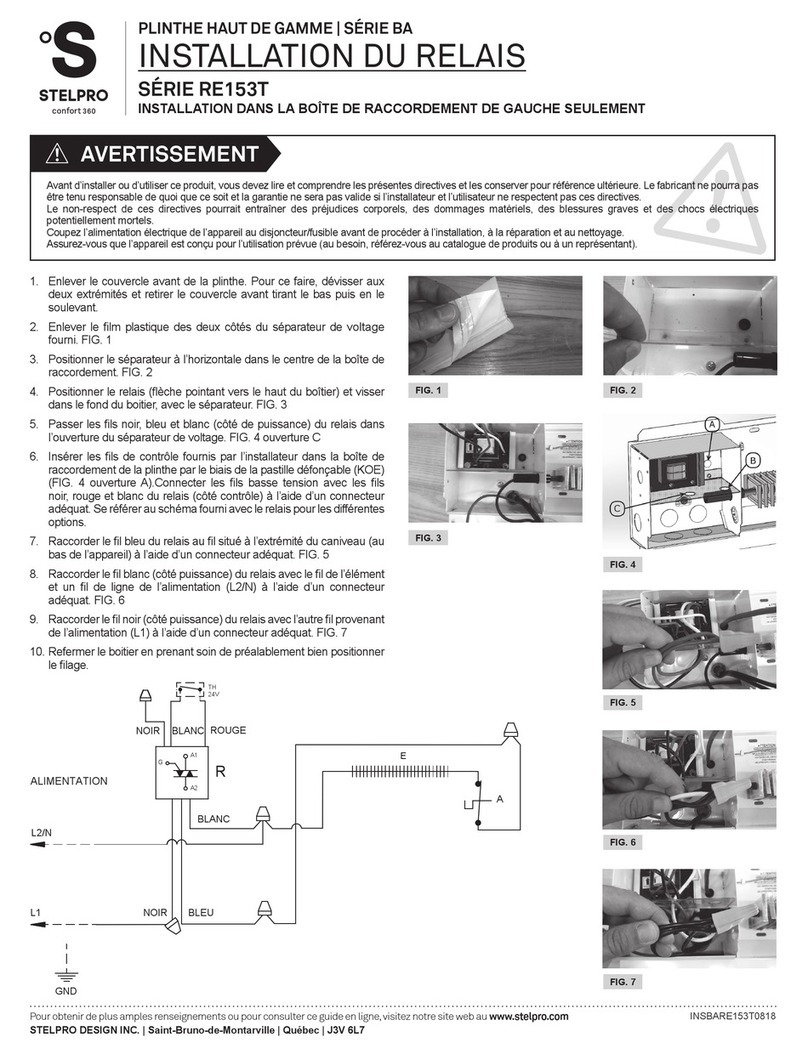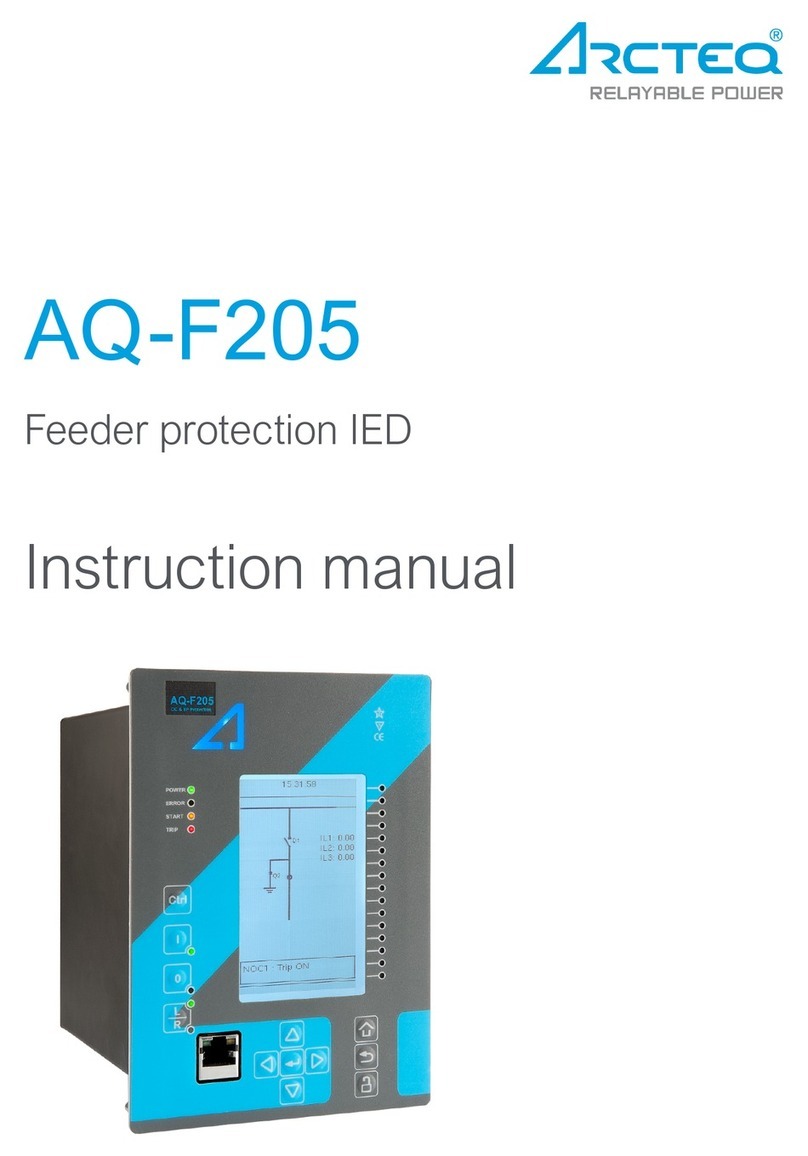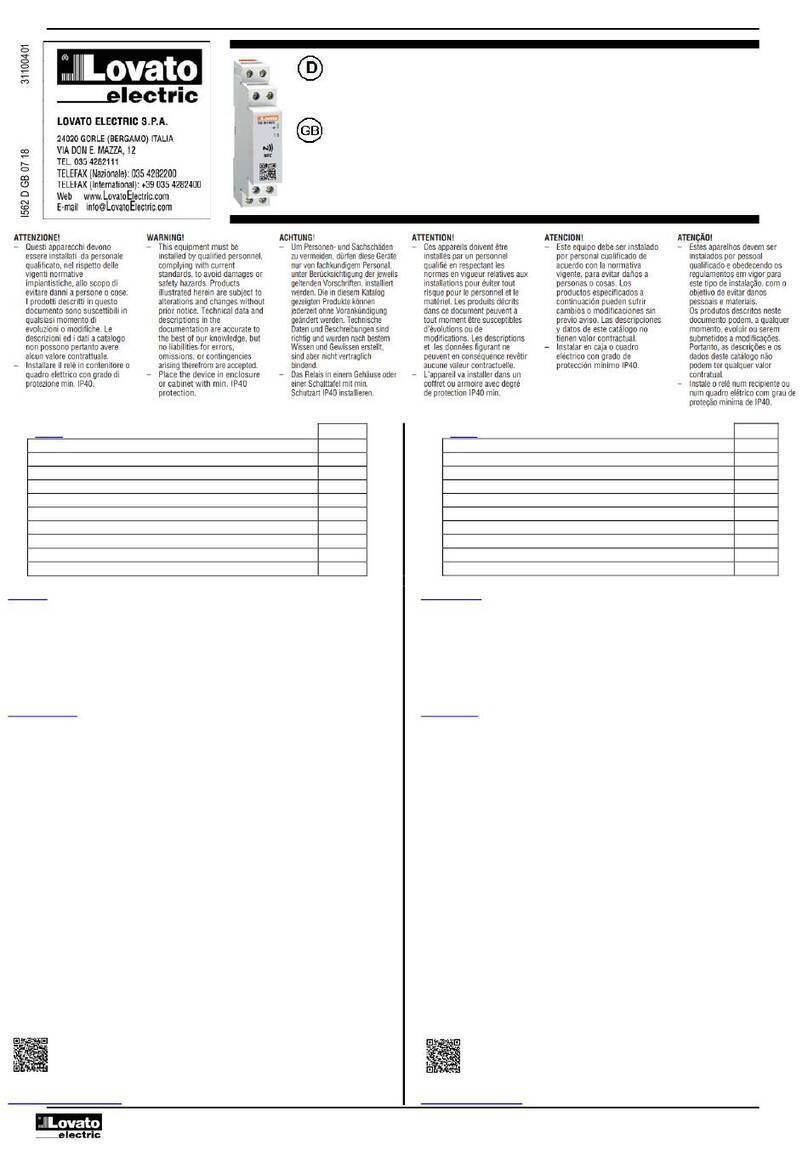Tsubaki TSBSS Series User manual

INSTRUCTION
MANUAL
TSUBAKI
TSUBAKITSUBAKI
TSUBAKI
E
EE
E&
&&
&M
MM
M
CO.
CO.CO.
CO.
WARNING
WARNINGWARNING
WARNING
1. Make sure you read this instruction manual thoroughly before installing,
wiring, operation and inspecting this SHOCK ELAY.
2. Please make sure that this instruction manual accompanies the SHOCK
ELAY to the end user.
3. Product specification are subject to change for improvement without
notice.
4. Disconnect power. Always lock out power switch before installing,
removing, or servicing unit. Comply with Occupational Safety and Health
Standards 1910. 147 “The Control of Hazardous Energy (Lock Out/Tag
Out).”
5. Install in proper enclosure in accordance with NEMA 250-1991
“Enclosures for Electrical Equipment (1000Volts Maximum)” and NFPA496
1993 edition “Purged and Pressurized Enclosures for Electrical
Equipment, 1993 Edition.” When revisions of these standards are
published, the updated edition shall apply.
6. Guards must be provided on all power transmission and conveyor
applications in accordance with provisions of ASME B15.1-1996 “Safety
Standards for Conveyors and elated Equipment, or other applicable
standards. When revision of these standards are published, the updated
edition shall apply.
!
!!
!
CAUTION
CAUTIONCAUTION
CAUTION
■ If danger is expected from your application, take the necessary
steps to ensure that it operates safely.
■ If your Tsubaki Emerson product does not operate normally, take
care to ensure that dangerous operating conditions do not occur.
■ Wear suitable clothing and protective equipment (safety glasses,
gloves, safety shoes, etc.)
■
Keep your work place tidy and safe to prevent accidents.
!
!!
!
SHOCK RELAY
SHOCK RELAYSHOCK RELAY
SHOCK RELAY
TSB
TSBTSB
TSBS
SS
SS
SS
S Series
Series Series
Series
E
EE
EHF
HFHF
HFSS
SSSS
SS05
0505
05.
..
.06
0606
060
00
01
11
1-
--
-9
99
9
20
2020
20
1
11
1
3
33
3
.
..
.
12.1
12.112.1
12.1

1
05 0.5 - 6 A
30 3 - 30 A
60 5 - 60 A
100 100A
200 200A
300 300A
1. Preface
Thank you for purchasing the Shock Relay TSBSS series.
This instruction anual describes everything fro installation to adjust ent.
Be sure to read this anual carefully before using your Shock Relay.
When delivering a device containing the Shock Relay, be sure that this instruction
anual is included.
2. TSBSS and TSB2CT Model identification
・
・・
・
Shock relay
TSB SS 05
Current Range:
Series: SS series
Model: Shock Relay
・
・・
・
External 2-phase CT
TSB 2CT 100
Rated pri ary current:
Series: 2-phase CT
Model: Shock Relay

2
3. Di ensions
・
・・
・
Shock relay
72
61
Attachment
Cover
Screw
(Unit 1inch=25.4 )

3
・
・・
・
External 2-phase CT
Details for installation holes

4
4. Specifications
Series TSB SS
Model Range
05 0.5-6A
30 3-30A
Current Setting *
1
60 5-60A
Starting Trip Delay
Start Ti e 0.2-30s
Ti e Setting *
1
Trip Ti e Shock Ti e
0.2-10s
Accuracy Current ±10% (Full scale )
Control Power Supply 100~240VAC±10%, 50/60Hz
Maxi u otor voltage 600VAC, 50/60Hz *
2
Current Sensing ethod 2 Integral Current Transfor er
Mode 1-SPDT(1c)
Contact Rating ( ax.) 3A / 240VAC cosφ=1
Contact Rating ( in.) *
3
10VDC 10 A
Operation Fail safe operation,Nor ally energized
Reset Manual or Electrical (Interrupt power supply)
Output Relay
Expected Life 100,000 operations
Operating -20 - +60℃ (-4 - +158 F)
Te perature
Storage -30 - +70℃ (-22 - +176 F)
Hu idity 45 – 85% RH without Condensation
Altitude 2,000 ax.
Pollution degree Class 3
To be free fro dust and corrosive gas
A bient
Environ ent
Vibration 5.9 /s2 or less.
Insulation Between casing and circuit Over 10MΩwith 500 VDC Megger
Between casing and circuit AC 2000V, 60Hz, 1 in
Between contacts AC 1000V, 60Hz, 1 in
Dielectric Strength
Between circuits and contacts AC 2000V, 60Hz, 1 in
Protection Structure IP20
115VAC 2.7 VA(0.35W)
Power Consu ption
230VAC 11.0 VA(1.2W)
Case Polya ide 66 (PA66)
Material
Ter inal cover Polya ide 6 (PA6)
Mounting 35 DIN rail or Panel
Di ension(W x H x D /Including Integral CT Windows) 54 x 72 x 64.5
Weight Less than 200g (0.44LBS) without External CT
*1 Current and ti e setting ranges can be set within the warranty range, but not the upper or lower
level of setting volu e.
*2 When Shock Relay is used with Inverter, the output frequency of Inverter should be fro 30Hz
to 60Hz.
*3 When directly inputting output relay contact into the progra able controller (PLC), be aware
that a inute electric current can cause contact failure
.
As for the input to PLC, it is co ended
to drive the relay coil for inute current by relay signal of Shock Relay at first, then input this
relay contact to PLC.
*4 CE arking
EMC Directive 03.05.1989 Low Voltage Directive 19.02.1973
EN60947-1 2001 EN50081-2 1993 EN55011 1991
EN50082-2 1995 EN61000-4-2 2002 (4kV)

5
5. Installation
1. Environ ental specifications
Install the Shock Relay in the following environ ent.
• Te perature: -20 to +60℃ not in direct sunlight.
• Hu idity: 45~85% relative hu idity without condensation and freezing.
• Place: Indoors, no water splash.
• At osphere: Free fro dust, corrosion gas, and oil ist.
• Height: 2000 or less above sea level.
•
Vibration: 5.9 /s
2
and under.
2. Installation to the panel
Put the Attach ent for installation at the both side or Shock Relay, and install
Shock Relay to the panel
3. Installation to the DIN rail
While pulling the hook of Shock Relay to the arrow direction, install Shock Relay
to 35 DIN rail. When re oval, put the hook to the arrow direction with
flathead screwdriver.
6. Wiring
(1) Connect 100-240VAC power source to the ter inal L1- L2.
Never connect the output of an inverter or a servo driver to ter inals L1-L2.
Install an insulation transfor er between the power line and ter inals L1-L2 of
the SHOCK RELAY when har onic noise is included in the power line.
(2) Check and correct the following ite s before turning the power on.
a. Is there any isconnection?
b. Have you forgotten to co plete any connections?
c. Are there any abnor al conditions such as a short-circuit or ground fault?
WARNING
ELECTRICAL SHOCK AND BURN
Do not operate without the ground wire connected.
7. Ter inal Function
Ter inal
Function
. Contents.
L1
L2
Power
Supply
100 – 240VAC co ercial power supply is wired
95 Co on
96 Nor ally close
(Power on : open Power off or tripped: close)
98
Output
Relay
Nor ally open
(Power on : close Power off or tripped: open)
Pull a hook in the direction of the arrow with a screwdriver to
re ove the bracket.
Mounting hole
hook
!
!!
!
63
2-M4
Attachment
L1
L2
95
96
98

6
8. Current Transfor er
Select the nu ber of wires passing through the CT (Current Transfor er) by using the following
table for best perfor ance. When two otor leads pass through the CT, the current sensed by
the CT is twice the otor current flowing through the otor lead.
AC 200 ~ 230 Volt Motor
AC 400 ~ 460 Volt Motor
Motor
Capacity
(kW)
Motor
Capacity
(Hp)
TSBSS
TYPE
Wires
passing
through CT
Motor
Capacity
(kW)
Motor
Capacity
(Hp)
TSBSS TYPE
Wires
passing
through CT
0.1 1/8 TSBSS05 4 - - - -
0.2 1/4 TSBSS05 3 0.2 1/4 TSBSS05 4
0.4 1/2 TSBSS05 2 0.4 1/2 TSBSS05 3
0.75 1 TSBSS05 1 0.75 1 TSBSS05 2
1.5 2 TSBSS30 3 1.5 2 TSBSS05 1
2.2 3 TSBSS30 2 2.2 3 TSBSS05 1
3.7 5 TSBSS30 1 3.7 5 TSBSS30 3
5.5 7-1/2 TSBSS30 1 5.5 7-1/2 TSBSS30 2
7.5 10 TSBSS60 1 7.5 10 TSBSS30 1
11 15 TSBSS60 1 11 15 TSBSS30 1
- - - - 15 20 TSBSS60 1
- - - - 18.5 25 TSBSS60 1
- - - - 22 30 TSBSS60 1
Basic wiring diagra
M : T
HREE-PHASE
M
OTOR
MC : Magnetic contactor
ON : Start switch
OFF : Stop switch
Fuse : Fuse
Tr : Transfor er
1. A transfor er ay be required,
depending on the voltage of Motor (i.e.
over 240VAC)
2. Output relay is nor ally energized
when there is power to the Shock
Relay. When Shock Relay trips, the
contacts change state.
3. Two of three phases of the otor are
passed through the Shock Relay’s CT
in the sa e direction.
4. A fire ight be happened as there is
no protection circuit in ain circuit.
5. Please select a fuse capacity
depending upon capacity of a
contactor MC to be connected.
M:
S
INGLE-PHASE
M
OTOR
Short circuit
SS
Nor ally Energized.

7
9. TSB2CT(
((
(External 2-phase CT)
))
)
・
・・
・Specifications
Model No. TSB2CT100 TSB2CT200 TSB2CT300
Class 3
Rated pri ary current 100A 200A 300A
Rated secondary current
5A
Rated burden 5VA
Rated frequency 50/60Hz
Approxi ately weight 0.5kg
・
・・
・Installation
Procedure
1. Install the SHOCK RELAY on the External CT with screws according to
Figure 1.
2. Connect the wire between “
“ and “
λ
λλ
λ
“ after passing the wire through CT hole
According to Figure 2.

8
OUTPUT
POWER
INPUT
95 96 98 L1 L2
RESET
③SHOCK TIME knob
0.2-10sec
TEST
MON L
ED
①START TIME knob
0.2-30sec
CT
②CURRENT knob
OC
L
ED
10. Construction
Description
Shock Relay senses the otor current passing through the two CTs and auto atically
detects the starting of the otor.
Shock Relay filters out the large starting current during the start-up delay preset with the
START TIME knob.
Shock Relay detects an overload by co paring the CT-sensed otor current with the trip
current that is preset with the CURRENT knob.
When the otor current exceeds the preset trip current level, the Shock Relay trips after the
trip delay that is preset with the SHOCK TIME knob.
Shock Relay can be used as an electronic shear-pin for a otor-driven achine.
Every ti e that the Shock Relay trips, always investigate the cause of the overload and
correct the cause.
Release the tripped Shock Relay by pressing the RESET button or by shutting power down
before restarting the equip ent.
As a fail-safe, the Shock Relay keeps the built-in output relay operating except when trips
occur, provided that power is applied to the Shock Relay.
Shock Relay lights the OC LED when sensing a greater current than preset with the
CURRENT knob and re ains lit after the relay trips. MON LED (green) shows onitor
condition. It is turned on under the nor al onitor condition, and the relay turns off the lights
while it is outputted.
Shock Relay provides a TEST button to confir the operation of the output relay and the two
ti ers -START TIME and SHOCK TIME. The Shock Relay trips after the total of the
START TIME and the SHOCK TIME when the TEST button is pressed and held.
T1
Motor speed
Shock Relay
trips
Motor current
A pere
TIME
Preset
Power
Input
MOTOR
STOP
OVER LOAD
T1<T0
① START TIME
③ SHOCK TIME
( T0 )
② Current
Output
Relay
MAX 0.5s
③ SHOCK TIME
( T0 )
OVER LOAD
T0<T2
T2
OC LED
Flicker
Continue
Flicker

9
11. Set up
1. Set START TIME knob (start-up delay) at the start-up ti e if the start-up ti e is known.
Set START TIME knob (start-up delay) at the axi u if the start-up ti e is unknown.
2. Set SHOCK TIME knob (trip delay ti er) at the desired trip ti e.
3. Set CURRENT knob (trip current) at the rated current of the otor.
4. Supply control voltage to the Shock Relay. Then confir that the SHOCK TIME activates
its built-in output relay – the contacts will change state.
5. Press and hold the TEST button. Confir that the Shock Relay lights its OC LED and
trips after total of the START TIME and SHOCK TIME. Confir that this also deactivates
the built-in output relay.
6. Press the RESET button. Confir that the OC LED turns off and that the built-in output
relay activates.
7. Start the otor and check that the start-up ti e was correctly set. Then slowly turn the
CURRENT knob counter clockwise until the Shock Relay flashes its LED. At this point,
the CURRENT knob indicates 100% of the otor running current.
8. Set the CURRENT knob at the proper trip current, this is co only at 110% of the actual
otor running current.
9. Recheck and adjust the START TIME knob so that it is a little longer than the nor al
start-up ti e.
12. Troubleshooting
Trouble Check Result Solution
Wiring of the power source
(L1-L2)
Not attached
correctly
Wire properly. Even when the Shock
Relay trips, the 95-98
contacts do not shut
down the attached
otor.
Power source voltage
(L1-L2) by voltage tester
Out of source
voltage
Supply 100-240V AC voltage
Model no. of the SHOCK
RELAY
See the na eplate
Incorrect size
Shock Relay
Switch to the correct Shock
Relay
Nu ber of wires passing
through the CT
I proper Rewire properly
The Shock Relay does
not trip even with the
CURRENT knob set to
the ini u
Press and hold TEST button
It does not trip Exchange SHOCK RELAY for a
new one
CURRENT knob setting Set too low Turn CURRENT knob CW and
set it properly
During start-up, an
overload trip occurs.
START TIME knob setting Set too short. Turn START TIME knob CW
and set it properly
CURRENT knob setting Set too low Turn CURRENT knob CW and
set it properly
During operation,
overload trip occurs.
SHOCK TIME knob setting Set too short. Turn SHOCK TIME knob CW
and set it properly
CURRENT knob setting Set too high Turn CURRENT knob CCW and
set it properly
SHOCK TIME knob setting Set too long Turn SHOCK TIME knob CCW
and set it properly
Shock Relay does not
trip with an overload
occurs
Press and hold TEST button
It does not trip Exchange SHOCK RELAY for
new one
If replace ent of the shock Relay is necessary, please ake contact with our co pany office.

10
13. Maintenance
(1) To prevent an accident, keep the surrounding area clean and create a safe environ ent.
(2) Before checking the installation and connection of the Shock Relay, turn off the power source.
Be sure that the equip ent is co pletely stopped and the OC LED of the Shock Relay is off.
Make sure that the power source is locked out and cannot be accidentally turned on.
14. Daily check and periodic check
(1) Confir that there is no looseness in the installation of the Shock Relay and current
transfor er. Check the wiring connections every six onths.
(2) Regularly check the function of the output relay, ter inal 95-96, ter inal 97-98, by pressing
the TEST button.
(3) A typical life ti e of electrolytic capacitor ounted in the SHOCK RELAY is about 10 years at
an average a bient te perature of 30℃, but this lifeti e ay vary with a different a bient
environ ent and with the operating period when power is supplied. We reco end you to
exchange the Shock Relay for a new one before trouble occurs.
15. Point for safe use
(1) Take easures beforehand to prevent danger when using a TSUBAKI product.
(2) If our product begins to operate i properly, be sure to take easures to prevent a
dangerous situation fro arising.
16. Warranty
1
11
1. Range of warranty
With regard to any troubles happened to our products, replace ent or repair of such troubled
parts will be provided for free of charge during the effective period of warranty, provided that
installation and aintenance/ anage ent of said products have been perfor ed properly
pursuant to the description of this instruction anual and said products have been used under
the condition described in the brochures or agreed separately through utual consultations.
The content of warranty is li ited only to the Shock Relay itself delivered to you and the
judg ent thereof will be ade by our selection because such judg ent pertaining to the range
of warranty is often co plex.
2
22
2 . Warranty period
The warranty period shall be either 18 onths after ship ent fro our factory or 12 onths
after starting operation, whichever is shorter. Any and all inspection/repair undertaken by us
after the above warranty period has passed will be charged. Should questions arise, please
do not hesitate to contact us or the dealer fro who you purchased.
3
33
3 . Miscellaneous
(1) Any atters described in this instruction anual are subject to change without notice.
(2) We have tried our best in preparing the contents of this instruction anual. Should any
istake or oversight be found, we will be ore than happy if you would advice us of the .

This manual suits for next models
3
Table of contents
Other Tsubaki Relay manuals

